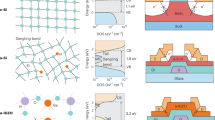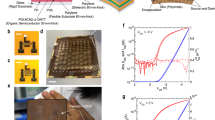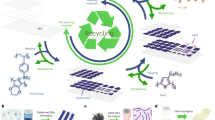Abstract
Organic electronics are beginning to make significant inroads into the commercial world, and if the field continues to progress at its current, rapid pace, electronics based on organic thin-film materials will soon become a mainstay of our technological existence. Already products based on active thin-film organic devices are in the market place, most notably the displays of several mobile electronic appliances. Yet the future holds even greater promise for this technology, with an entirely new generation of ultralow-cost, lightweight and even flexible electronic devices in the offing, which will perform functions traditionally accomplished using much more expensive components based on conventional semiconductor materials such as silicon.
This is a preview of subscription content, access via your institution
Access options
Subscribe to this journal
Receive 51 print issues and online access
$199.00 per year
only $3.90 per issue
Buy this article
- Purchase on Springer Link
- Instant access to full article PDF
Prices may be subject to local taxes which are calculated during checkout







Similar content being viewed by others
References
Vaeth, K. M. OLED-display technology. Inform. Display 19, 12–17 (2003)
Lin, Y. Y., Gundlach, D. J., Nelson, S. F. & Jackson, T. N. in 55th Annu. Dev. Res. Conf. 60 (Electron Device Society, Ft Collins, Colorado, 1997)
Gundlach, D. J., Lin, Y. Y. & Jackson, T. N. Pentacene organic thin film transistors—molecular ordering and mobility. IEEE Electron. Dev. Lett. 18, 87–89 (1997)
Shtein, M., Mapel, J., Benziger, J. B. & Forrest, S. R. Effects of film morphology and gate dielectric surface preparation on the electrical characteristics of organic vapor phase deposited pentacene thin-film transistors. Appl. Phys. Lett. 81, 268–270 (2002)
Peumans, P. & Forrest, S. R. Very high efficiency double heterostructure copper phthalocyanine/C60 photovoltaic cells. Appl. Phys. Lett. 79, 126–128 (2001)
Granstrom, M. et al. Laminated fabrication of polymeric photovoltaic diodes. Nature 395, 257–260 (1998)
Peumans, P., Uchida, S. & Forrest, S. R. Efficient bulk heterojunction photovoltaic cells based on small molecular weight organic thin films. Nature 425, 158–162 (2003)
Shaheen, S. E. et al. 2.5% efficient organic plastic solar cells. Appl. Phys. Lett. 78, 841–843 (2001)
Baldo, M. A. et al. High efficiency phosphorescent emission from organic electroluminescent devices. Nature 395, 151–154 (1998)
Anthopoulos, T. D. et al. Highly efficient single-layer dendrimer light-emitting diodes with balanced charge transport. Appl. Phys. Lett. 82, 4824–4826 (2003)
Ma, D. G. et al. Bright electroluminescence from a new conjugated dendrimer. Synth. Met. 137, 1125–1126 (2003)
Lee, C.-L., Lee, K. B. & Kim, J.-J. Polymer phosphorescent light emitting devices doped with tris(2-phenylpyridine) iridium as a triplet emitter. Appl. Phys. Lett. 77, 2280–2282 (2000)
Burroughes, J. H. et al. Light-emitting diodes based on conjugated polymers. Nature 347, 539–541 (1990)
Braun, D. & Heeger, A. J. Visible light emission from semiconducting polymer diodes. Appl. Phys. Lett. 58, 1982–1984 (1991)
Greenbaum, E., Blankinship, S. L., Lee, J. W. & Ford, R. M. Solar photobiochemistry: Simultaneous photoproduction of hydrogen and oxygen in a confined bioreactor. J. Phys. Chem. B 105, 3605–3609 (2001)
Greenbaum, E., Lee, I. & Lee, J. W. Functional 3D nanoscale imaging of a single-molecule photovoltaic structure. Biophys. J. Part 2 82, 206–207 (2002)
Pope, M. & Swenberg, C. E. Electronic Processes in Organic Crystals (Clarendon, Oxford, 1982)
Silinsh, E. A. in Organic Molecular Crystals (ed. Queisser, H.-J.) Ch. 1 (Springer, Berlin, 1980)
Sze, S. M. Physics of Semiconductor Devices (John Wiley, New York, 1981)
Warta, W., Stehle, R. & Karl, N. Ultrapure, high mobility organic photoconductors. Appl. Phys. A 36, 163–170 (1985)
Karl, N. Studies of organic semiconductors for 40 years. III. Mol. Cryst. Liq. Cryst. 171, 31–51 (1989)
Forrest, S. R., Kaplan, M. L. & Schmidt, P. H. Organic-on-inorganic semiconductor contact barrier diodes. II. Dependence on organic film and metal contact properties. J. Appl. Phys. 56, 543–551 (1984)
Campbell, A. J., Bradley, D. D. C. & Antoniadis, H. Dispersive electron transport in an electroluminescent polyfluorene copolymer measured by the current integration time-of-flight method. Appl. Phys. Lett. 79, 2133–2135 (2001)
Blom, P. W. M., de Jong, M. J. M. & vanMunster, M. G. Electric-field and temperature dependence of the hole mobility in poly(p-phenylene vinylene). Phys. Rev. B 55, R656–R659 (1997)
Bulovic, V., Burrows, P. E. & Forrest, S. R. in Electroluminescence I (ed. Mueller, G.) 262 (Academic, New York, 2000)
Sirringhaus, H. et al. Mobility enhancement in conjugated polymer field-effect transistors through chain alignment in a liquid-crystalline phase. Appl. Phys. Lett. 77, 406–408 (2000)
Forrest, S. R. Ultrathin organic films grown by organic molecular beam deposition and related techniques. Chem. Rev. 97, 1793–1896 (1997)
van de Craats, A. M. et al. Meso-epitaxial solution-growth of self organizing discotic liquid-crystalline semiconductors. Adv. Mat. 15, 495–499 (2003)
Burrows, P. E. & Forrest, S. R. Electroluminescence from trap-limited current transport in vacuum deposited organic light emitting devices. Appl. Phys. Lett. 64, 2285–2287 (1994)
Parker, I. D. Carrier tunneling and device characteristics in polymer light emitting diodes. J. Appl. Phys. 75, 1656–1666 (1994)
Gelinck, G. H., Geuns, T. C. T. & de Leeuw, D. M. High-performance all-polymer integrated circuits. Appl. Phys. Lett. 77, 1487–1489 (2000)
Drury, C. J., Mutsaers, C. M. J., Hart, C. M., Matters, M. & de Leeuw, D. M. Low-cost all-polymer integrated circuits. Appl. Phys. Lett. 73, 108–110 (1998)
Peumans, P., Bulovic, V. & Forrest, S. R. Efficient, high-bandwidth organic multilayer photodetectors. Appl. Phys. Lett. 76, 3855–3857 (2000)
Stutzmann, N., Friend, R. H. & Sirringhaus, H. Self-aligned vertical-channel polymer field effect transistors. Science 299, 1881–1884 (2003)
Kitaigorodsky, A. I. Molecular Crystals and Molecules (Academic, New York, 1973)
Werner, A. G. et al. Pyronin B as a donor for n-type doping of organic thin films. Appl. Phys. Lett. 82, 4495–4497 (2003)
Fukase, A. & Kido, J. Organic electroluminescent devices having self-doped cathode interface layer. Jpn. J. Appl. Phys. 2 41, L334–L336 (2002)
Kido, J. & Matsumoto, T. Bright organic electroluminescent devices having a metal-doped electron-injecting layer. Appl. Phys. Lett. 73, 2866–2868 (1998)
Endo, J., Matsumoto, T. & Kido, J. Organic electroluminescent devices with a vacuum-deposited Lewis-acid-doped hole-injecting layer. Jpn. J. Appl. Phys. 2 41, L358–L360 (2002)
Gao, W. & Kahn, A. Controlled p-type doping of an organic molecular semiconductor. Appl. Phys. Lett. 79, 4040–4042 (2001)
Pfeiffer, M., Forrest, S. R., Leo, K. & Thompson, M. E. Electrophosphorescent p-i-n organic light emitting devices for very high efficiency flat panel displays. Adv. Mater. 14, 1633–1636 (2002)
Do, L. M. et al. Observation of degradation processes of Al electrodes in organic electroluminescence devices by electroluminescence microscopy, atomic force microscopy, scanning electron microscopy and Auger electron spectroscopy. J. Appl. Phys. 76, 5118–5121 (1994)
Aziz, H. et al. Degradation processes at the cathode/organic interface in organic light emitting devices with Mg:Ag cathodes. Appl. Phys. Lett. 72, 2642–2644 (1998)
Burrows, P. E. et al. Reliability and degradation of organic light emitting devices. Appl. Phys. Lett. 65, 2922–2924 (1994)
Kwong, R. C. et al. High operational stability of electrophosphorescent devices. Appl. Phys. Lett. 81, 162–164 (2002)
Xu, G. Fighting OLED degradation. Inform. Display 19, 18–21 (2003)
Gutmann, F. & Lyon, L. E. Organic Semiconductors Part A (R. E. Krieger Publishing, Malabar, Florida, 1981)
Wu, C. C., Sturm, J. C., Register, R. A. & Thompson, M. E. Integrated three color organic light emitting devices. Appl. Phys. Lett. 69, 3117–3119 (1996)
Jiang, X. Z. et al. Effect of carbazole-oxadiazole excited-state complexes on the efficiency of dye-doped light-emitting diodes. J. Appl. Phys. 91, 6717–6724 (2002)
Gu, G. & Forrest, S. R. Design of flat panel displays based on organic light emitting devices. IEEE J. Sel. Top. Quant. Electron. 4, 83–99 (1998)
Hebner, T. R. & Sturm, J. C. Local tuning of organic light-emitting diode color by dye droplet application. Appl. Phys. Lett. 73, 1775–1777 (1998)
Sirringhaus, H. et al. High-resolution inkjet printing of all-polymer transistor circuits. Science 290, 2123–2126 (2000)
Shimoda, T., Morii, K., Seki, S. & Kiguchi, H. Inkjet printing of light-emitting polymer displays. Mater. Res. Soc. Bull. 28, 821–827 (2003)
Hebner, T. R., Wu, C. C., Marcy, D., Lu, M. H. & Sturm, J. C. Ink-jet printing of doped polymers for organic light emitting devices. Appl. Phys. Lett. 72, 519–521 (1998)
Gustafsson, G. et al. Flexible light-emitting diodes made from soluble conducting polymers. Nature 357, 477–479 (1992)
Gu, G., Burrows, P. E., Venkatesh, S., Forrest, S. R. & Thompson, M. E. Vacuum-deposited, non-polymeric flexible organic light emitting devices. Opt. Lett. 22, 175–177 (1997)
Burrows, P. E. et al. Organic vapor phase deposition: a new method for the growth of organic thin films with large optical nonlinearities. J. Cryst. Growth 156, 91–98 (1995)
Shtein, M., Gossenberger, H. F., Benziger, J. B. & Forrest, S. R. Material transport regimes and mechanisms for growth of molecular organic thin films using low-pressure organic vapor phase deposition. J. Appl. Phys. 89, 1470–1476 (2001)
Shtein, M., Peumans, P., Benziger, J. B. & Forrest, S. R. Micropatterning of organic thin films for device applications using organic vapor phase deposition. J. Appl. Phys. 93, 4005–4016 (2003)
Shtein, M., Peumans, P., Benziger, J. & Forrest, S. R. . Direct, mask- and solvent-free printing of molecular organic semiconductors. Adv. Mater. (in the press)
Karnakis, D. M., Lippert, T., Ichinose, N., Kawanishi, S. & Fukumura, H. Laser induced molecular transfer using ablation of a triazeno-polymer. Appl. Surf. Sci. 127–129, 781–786 (1998)
Blanchet, G. B., Loo, Y.-L., Rogers, J. A., Gao, F. & Fincher, C. R. Large area, high resolution dry printing of conducting polymers for organic electronics. Appl. Phys. Lett. 82, 463–465 (2003)
Suh, M. C., Chin, B. D., Kim, M.-H., Kang, T. M. & Lee, S. T. Enhanced luminance of blue light-emitting polymers by blending with hole transporting materials. Adv. Mater. 15, 1254–1258 (2003)
Wang, J., Sun, X., Chen, L. & Chou, S. Y. Direct nanoimprint of submicron organic light-emitting structures. Appl. Phys. Lett. 75, 2767–2769 (1999)
Chou, S. Y., Zhuang, L. & Guo, L. Lithographically induced self-construction of polymer microstructures for resistless patterning. Appl. Phys. Lett. 75, 1004–1006 (1999)
Stutzmann, N., Tervoort, T. A., Bastiaansen, K. & Smith, P. Patterning of polymer-supported metal films by microcutting. Nature 407, 613–616 (2000)
Zaumseil, J. et al. Nanoscale organic transistors that use source/drain electrodes supported by high resolution rubber stamps. Appl. Phys. Lett. 82, 793–795 (2003)
Kim, C. & Forrest, S. R. Fabrication of organic light-emitting devices by low pressure cold welding. Adv. Mater. 15, 541–545 (2003)
Kim, C., Burrows, P. E. & Forrest, S. R. Micropatterning of organic electronic devices by cold-welding. Science 288, 831–833 (2000)
Acknowledgements
The author is indebted to his many students, and in particular M. Thompson, for many discussions over the years. He is also grateful to the Air Force Office of Scientific Research, the Defense Advanced Research Projects Agency, the National Science Foundation and Universal Display Corporation for their financial support of this work.
Author information
Authors and Affiliations
Corresponding author
Ethics declarations
Competing interests
The author declares that he has no competing financial interests.
Rights and permissions
About this article
Cite this article
Forrest, S. The path to ubiquitous and low-cost organic electronic appliances on plastic. Nature 428, 911–918 (2004). https://doi.org/10.1038/nature02498
Issue Date:
DOI: https://doi.org/10.1038/nature02498
This article is cited by
-
A figure of merit for efficiency roll-off in TADF-based organic LEDs
Nature (2024)
-
Inkjet-printed high-performance and mechanically flexible organic photodiodes for optical wireless communication
Scientific Reports (2024)
-
Theoretical investigation of new series diphenylsulfone derivatives suitable candidates for organic light-emitting diodes (OLEDS) applications
Structural Chemistry (2024)
-
Microwave-assisted C–C bond formation of diarylacetylenes and aromatic hydrocarbons on carbon beads under continuous-flow conditions
Communications Chemistry (2023)
-
Electro-capillary peeling of thin films
Nature Communications (2023)
Comments
By submitting a comment you agree to abide by our Terms and Community Guidelines. If you find something abusive or that does not comply with our terms or guidelines please flag it as inappropriate.



